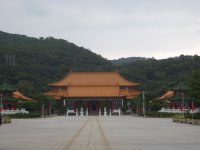
友人と台湾へ行って来ました。
第一印象は、日本にとても雰囲気の似た国だということです。でも、現在の日本ではなく、少し前の時代の日本です。台湾の人々、また建物や高速道路の構造なども似ていました。台北市内では、日本のデパートやセブンイレブン、ファミリーマートなどコンビニもたくさんあり、どこでも日本のお菓子や雑貨類がおいてありました。牛丼の吉野家もいたるところにあり、マクドナルド、スターバックス、モスバーガーもよく見かけました。地下鉄は、とてもわかりやすく、東京の運賃のおよそ半額。ほとんどのタクシーでは、英語も日本語も通じないので行き先を漢字で書いて見せると、すぐにわかってくれました。話をしなければ日本人とはわからないようで、私は一度、現地の人に、地下鉄の駅を聞かれました。それとも、私がすっかり馴染んでいたのでしょうか?台湾旅行2に続く。
I went to Taiwan with a friend.My first impression was that Taiwan was very similar to Japan. But it’s not current Japan, it’s like a little older Japan. Taiwanese people, the building constructions and the freeways were also similar. There were some Japanese department stores and many convenient stores, like, 7-11 and Family-Mart. They had many Japanese sweets and goods everywhere. And I saw many Yoshinoya, McDonalds, Starbucks and Mos Burger shops. It was very easy to use the subway, and the fare is almost half that of Tokyo. Most of taxi drivers didn’t speak English or Japanese, but I was able to communicate with them by using Kanji. Most of the people didn’t realize that I was Japanese until I spoke. Once a Taiwanese asked me where the subway station was. Did I really fit in that well? Traveling to Taiwan Part 2 to be continued next time.
第一印象は、日本にとても雰囲気の似た国だということです。でも、現在の日本ではなく、少し前の時代の日本です。台湾の人々、また建物や高速道路の構造なども似ていました。台北市内では、日本のデパートやセブンイレブン、ファミリーマートなどコンビニもたくさんあり、どこでも日本のお菓子や雑貨類がおいてありました。牛丼の吉野家もいたるところにあり、マクドナルド、スターバックス、モスバーガーもよく見かけました。地下鉄は、とてもわかりやすく、東京の運賃のおよそ半額。ほとんどのタクシーでは、英語も日本語も通じないので行き先を漢字で書いて見せると、すぐにわかってくれました。話をしなければ日本人とはわからないようで、私は一度、現地の人に、地下鉄の駅を聞かれました。それとも、私がすっかり馴染んでいたのでしょうか?台湾旅行2に続く。
I went to Taiwan with a friend.My first impression was that Taiwan was very similar to Japan. But it’s not current Japan, it’s like a little older Japan. Taiwanese people, the building constructions and the freeways were also similar. There were some Japanese department stores and many convenient stores, like, 7-11 and Family-Mart. They had many Japanese sweets and goods everywhere. And I saw many Yoshinoya, McDonalds, Starbucks and Mos Burger shops. It was very easy to use the subway, and the fare is almost half that of Tokyo. Most of taxi drivers didn’t speak English or Japanese, but I was able to communicate with them by using Kanji. Most of the people didn’t realize that I was Japanese until I spoke. Once a Taiwanese asked me where the subway station was. Did I really fit in that well? Traveling to Taiwan Part 2 to be continued next time.
5 件のコメント:
日本と似てるというのは、意外でした。
モスバーガーまであるんですね?
食事の面でも、日本人にとって、台湾は過ごしやすい場所かもしれませんね。
NYでも、アジア系の人はたくさんいますが
なんとなく日本人だな、とか中国の方かな、とか分かるような気がして
近寄ってみるとやっぱり日本語しゃべってた、とかいう事がよくあります。
顔だけを取ると似ていて区別がつきませんが
髪型やファッション、身のこなしなどから
国の特徴がうかがえると思います。
私はこっちでよく、「are you japanese?」と聞かれます。かなりダイレクトな質問で最初は戸惑いました。
Kozyさんは、すっかり台湾に溶け込まれていた様子ですね。
リラックスして良い時間を過ごされていた証拠だと思います。
第二弾を楽しみにしています。
Hi Kozy-san,
Ohisashiburi ...
Thanks for visiting my blog! I left a comment on my blog for you.
This is an interesting post on Taiwan. I would like to visit Taiwan someday, as I'm told that the National Museum in Taipei has what is considered the finest collection of Chinese art masterpieces in the world.
So many places to visit, but not enough time (or money) ...
P.S. The photo on this post looks a little like Byodo-in, but without the small pond in front.
そうですね、見のこなしで違いがわかると思います。
外国へ行った時に、カフェの窓際から外の人々を見るのが好きなのですが、だいたい日本人はわかります。
それにしても、私は、ベトナムでも向こうの人に間違われたので、大きな顔をして歩いているのかもしれません(一緒に行った友達いわく)。
Michael-san, I read your kind comment to me on your blog. Thank you.
Yes, I went to the National Palace Museum in Taipei and saw many incredible handicrafts of the ancient Chinese people.
That's amazing!
When I read your P.S. about Byodoin, I thought you knew a lot about Japan and I imagined 10 yen coin.
コメントを投稿